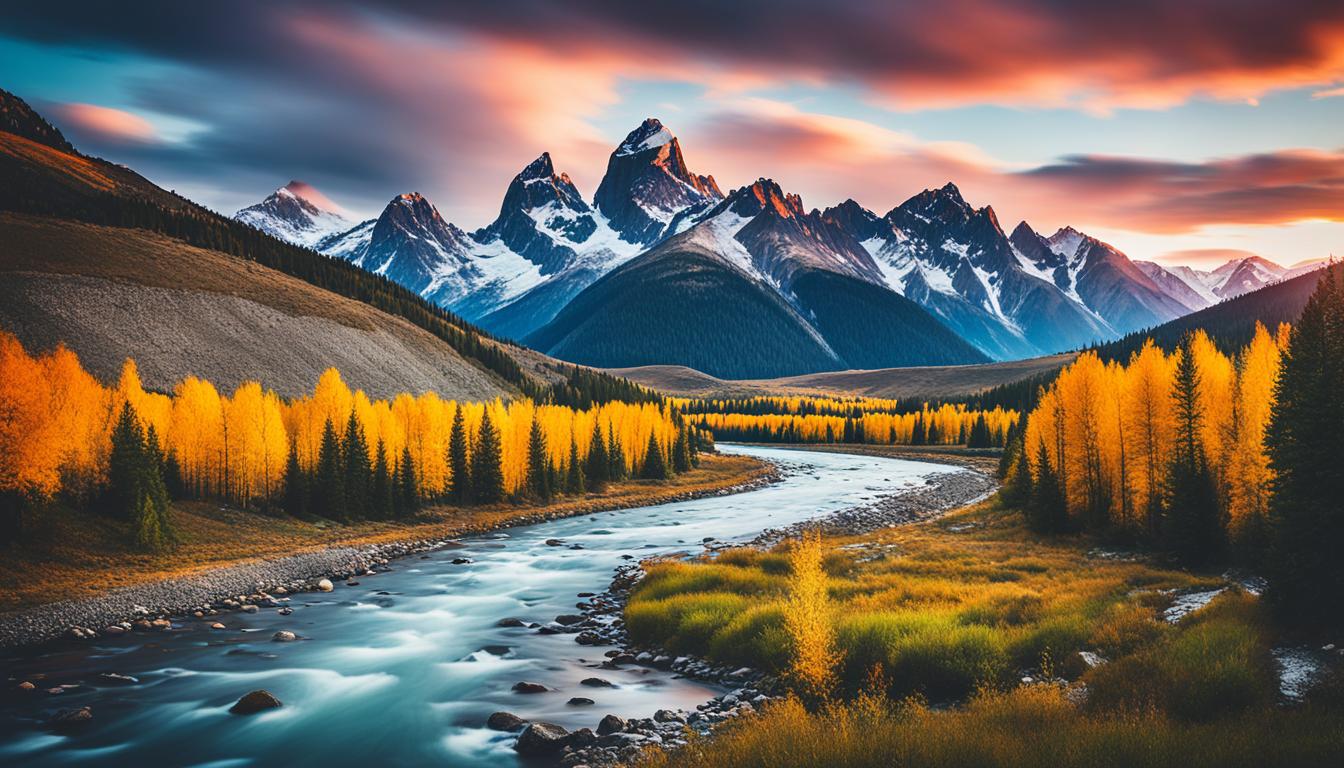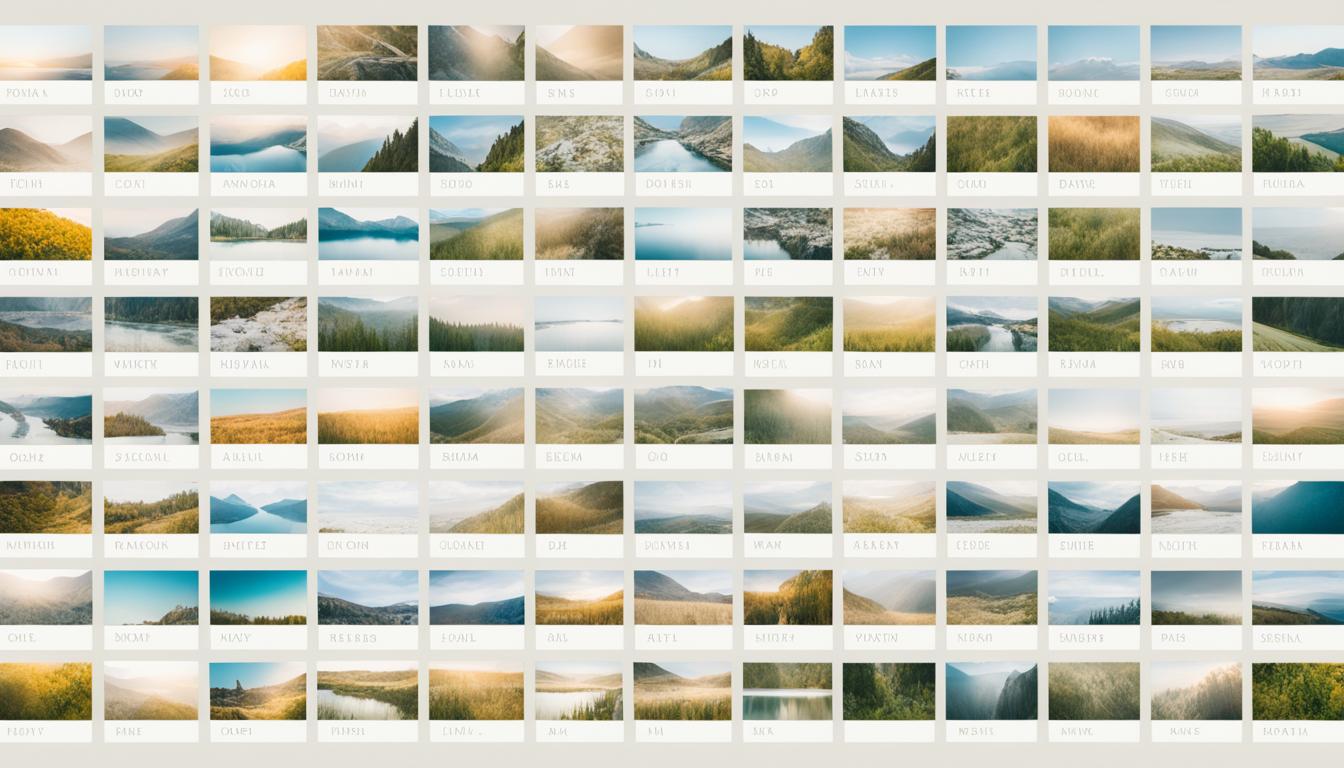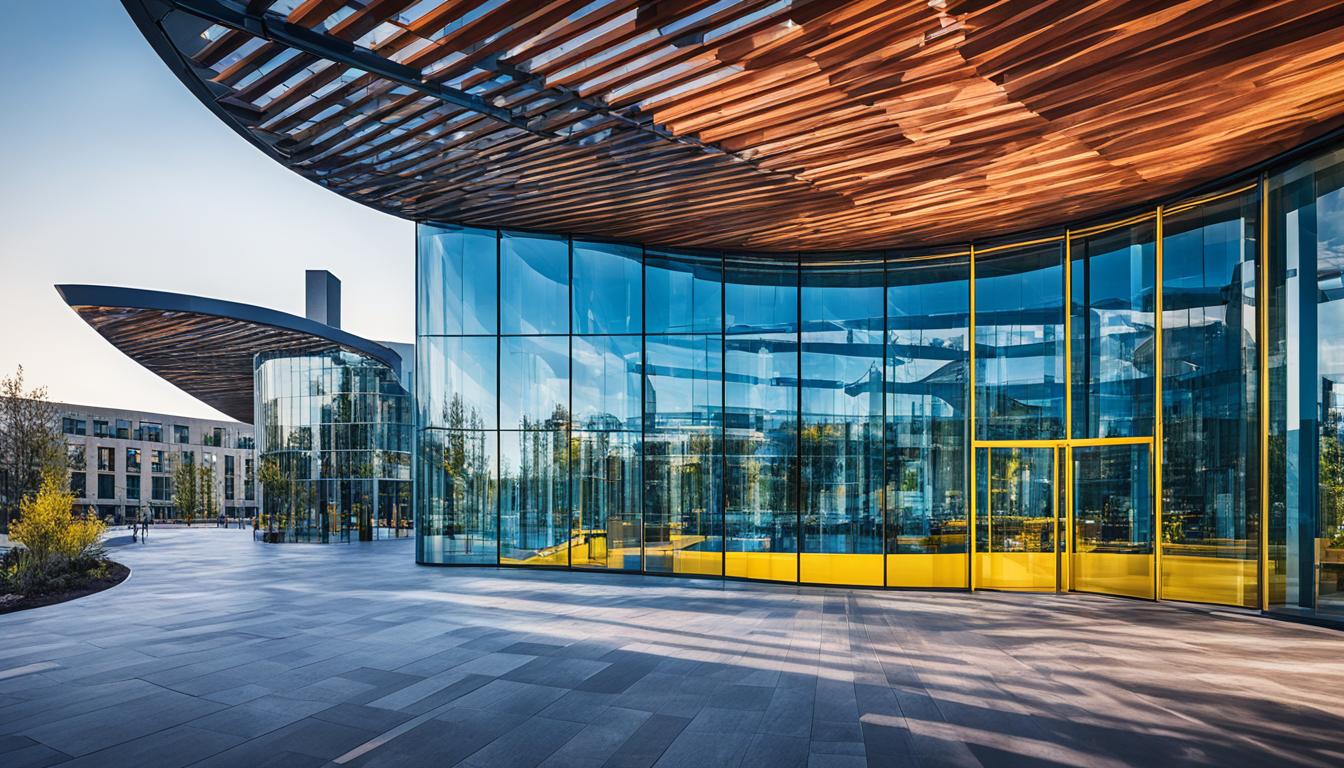Landscape photography is a beautiful art form that captures the stunning beauty of the natural world. However, to truly elevate your shots and create masterpieces, it’s essential to have some landscape photography editing tips in your arsenal. By applying various photo editing techniques, using the best editing software for landscapes, and enhancing your landscape images, you can take your photography skills to the next level. In this article, we will explore professional photo editing tips, landscape photography post-processing techniques, and advanced photo editing tricks to help you improve your landscape photo composition.
Key Takeaways:
- Learn professional photo editing tips to enhance your landscape images.
- Discover the best editing software for landscapes.
- Explore landscape photography post-processing techniques to elevate your shots.
- Uncover advanced photo editing tricks for stunning results.
- Improve your landscape photo composition for visually captivating images.
How to Find the Best Lighting for Landscape Photography.
One of the most crucial aspects of landscape photography is finding the best lighting conditions. The right lighting can dramatically enhance the beauty of your landscapes and make your images more captivating. Here are some tips to help you capture the perfect light for your landscape photography:
1. Sunrise and Sunset Photography
Sunrise and sunset provide the best natural light for landscape photography, known as the golden hour. During these times, the sun is low in the sky, creating soft, warm light that adds a magical touch to your images. The warm hues and long shadows can bring out the texture and depth of your landscapes, making them more visually stunning.
2. Shooting During the Blue Hour
The blue hour is a period of time before sunrise and after sunset when the sky takes on a deep blue color. This atmospheric lighting can create a serene and ethereal feel in your landscape photos. The soft, diffused light during the blue hour can add a sense of tranquility and mystery to your images.
3. Planning for the Best Light
Before heading out for a landscape photography shoot, it’s essential to plan and research the best lighting conditions for your desired location. Use apps or websites that provide information about sunrise, sunset, and the golden hour. By knowing when and where the best light will be, you can be prepared to capture breathtaking images.
4. Impact of Weather Conditions on Lighting
Weather conditions play a significant role in the quality of light for landscape photography. Clear skies during sunrise and sunset create vibrant colors and beautiful contrasts. Cloudy or partly cloudy skies can diffuse the light, creating a soft and even lighting across the landscape. Rain or stormy weather can also add drama and mood to your images.
| Lighting Condition | Description |
|---|---|
| Sunrise and Sunset | Soft, warm light with long shadows and vibrant colors |
| Blue Hour | Deep blue atmospheric lighting before sunrise and after sunset |
| Clear Skies | Vibrant colors and beautiful contrasts |
| Cloudy/Partly Cloudy | Diffused, soft lighting across the landscape |
| Rain/Stormy Weather | Drama and mood added to your images |
By understanding the different lighting conditions and their impact on your landscapes, you can strategically plan your shoots to capture the best light. Experiment with different times of the day and weather conditions to create unique and stunning landscape photographs.
Remember, lighting is a powerful tool in landscape photography, and finding the right light can transform an ordinary scene into something extraordinary. Incorporate these lighting tips and techniques into your photography workflow to capture breathtaking landscape images.
Incorporating a Human Element in Landscape Photography.
Adding a human element to your landscape images can bring a new dimension to your photos, creating a sense of scale and perspective that allows viewers to better understand the grandeur of the landscape. By incorporating a person or other subject in your composition, you provide a point of reference, showcasing the enormity of the surroundings and engaging viewers in a more profound way.
Not only does the inclusion of a human element add visual interest, but it also creates an emotional connection between the viewer and the photograph. It allows viewers to imagine themselves in the scene, evoking a sense of awe and wonder. By showcasing the grandeur of the landscapes through the inclusion of human subjects, you invite viewers to explore and experience the natural beauty captured in the image.
To effectively incorporate a human element in your landscape photography, consider employing various composition techniques. The rule of thirds, for example, can help you create a balanced and visually appealing composition. By placing your subject off-center, either along the vertical or horizontal lines of the grid, you can create a more dynamic and engaging photo.
Another composition technique to consider is the use of leading lines. These lines can guide the viewer’s eyes through the image and create a sense of depth and perspective. Look for natural elements in the landscape, such as paths, rivers, or tree branches, that can serve as leading lines, drawing attention to your subject and adding depth to the composition.
Ultimately, incorporating a human element in your landscape photography allows you to create more captivating and emotionally evocative images. It not only showcases the grandeur of the landscapes but also engages viewers on a deeper level. By using composition techniques such as the rule of thirds and leading lines, you can capture stunning landscape photos that leave a lasting impression.

| Benefits of Incorporating a Human Element | Composition Tips |
|---|---|
|
|
Choosing the Right Gear for Landscape Photography.
When it comes to capturing stunning landscape photographs, having the right gear is essential. The gear you use can greatly impact the quality and creativity of your images. Let’s explore the must-have landscape photography gear and accessories that can help take your photography to the next level.
Best Camera for Landscapes
For landscape photography, it’s recommended to use a full-frame DSLR or mirrorless camera. These cameras offer high resolution and excellent low-light capabilities, allowing you to capture every detail of the landscape with stunning clarity. Some popular options include the Nikon D850, Canon EOS 5D Mark IV, and Sony Alpha a7R III.
Recommended Lenses for Landscape Photography
Choosing the right lenses is crucial for capturing the expansive beauty of landscapes. Wide-angle lenses, such as the Canon EF 16-35mm f/2.8L III USM or the Nikon AF-S Nikkor 14-24mm f/2.8G ED, are perfect for capturing the vastness and depth of landscapes. Telephoto lenses, like the Sony FE 70-200mm f/2.8 GM OSS or the Nikon AF-S Nikkor 70-200mm f/2.8E FL ED VR, are ideal for isolating specific elements and creating beautiful compressed perspectives.
Importance of Tripods
A sturdy tripod is an essential tool for landscape photographers. It provides stability and allows you to capture sharp images, especially in low-light situations or when utilizing longer exposure times. Look for tripods made of durable materials like carbon fiber, which offer both stability and portability. Some popular options include the Manfrotto 055 Carbon Fiber Tripod and the Gitzo Series 2 Traveler Carbon Fiber Tripod.
Using Filters in Landscape Photography
Filters can greatly enhance your landscape images by controlling light and reducing reflections. Circular polarizers are commonly used to intensify colors and reduce glare, especially when photographing bodies of water or foliage. Neutral density (ND) filters are also valuable tools for landscape photographers as they allow you to create long exposures, capturing the movement of clouds or water. Some well-regarded filter brands include Lee Filters, B+W, and Breakthrough Photography.
Essential Accessories for Landscape Photographers
In addition to cameras, lenses, and tripods, there are a few essential accessories that every landscape photographer should have. A comfortable backpack will not only protect your gear but also make it easier to carry during long hikes or explorations. Extra batteries are a must to ensure you never miss a shot due to a drained battery. Additionally, storage solutions like memory cards and external hard drives are essential for keeping your images safe and organized.
| Item | Recommended Brands |
|---|---|
| Camera | Nikon, Canon, Sony |
| Wide-Angle Lens | Canon, Nikon, Sony |
| Telephoto Lens | Sony, Nikon |
| Tripod | Manfrotto, Gitzo |
| Filters | Lee Filters, B+W, Breakthrough Photography |
| Backpack | Lowepro, F-Stop |
| Extra Batteries | Canon, Nikon, Sony |
| Memory Cards | SanDisk, Lexar |
| External Hard Drives | Seagate, Western Digital |
Camera Settings for Landscape Photography.
Understanding the right camera settings is crucial for capturing stunning landscape photos. By shooting in Manual mode, we have full control over the exposure variables, allowing us to adjust the aperture, shutter speed, and ISO according to our desired outcome.
To achieve maximum depth of field, a desired effect in landscape photography, we can use a narrow aperture (high f-number) to keep the entire scene in focus. This ensures that both the foreground and background elements are sharp and detailed.
Another technique we can use is pairing a narrow aperture with a slow shutter speed. This allows more light to enter the camera, compensating for the reduced light caused by the narrow aperture. It also creates a beautiful motion blur effect for elements like flowing water or moving clouds, adding a sense of dynamism to the image.
Controlling the ISO is also essential in landscape photography. By keeping the ISO low, we can prevent noise and maintain excellent image quality. Lower ISO values produce cleaner images, especially in situations with sufficient natural light.
| Camera Setting | Function |
|---|---|
| Aperture | Adjust the amount of light entering the lens and control depth of field |
| Shutter Speed | Determine the length of time the camera’s sensor is exposed to light |
| ISO | Control the sensitivity of the camera’s sensor to light |
By mastering the use of these camera settings, we can have full control over the exposure and create breathtaking landscape photos that captivate our viewers.
Composition Techniques for Landscape Photography.
Composition plays a vital role in creating visually appealing landscape photographs. By utilizing various composition techniques, you can elevate your landscape shots and capture extraordinary images that truly reflect the beauty of the natural world.
Rule of Thirds
The rule of thirds is a fundamental principle in landscape photography composition. It involves dividing your frame into a grid of nine equal parts by drawing two horizontal lines and two vertical lines. By placing key elements along these lines or at their intersections, you can create a well-balanced and visually pleasing composition.
Leading Lines
Leading lines are another powerful composition technique that guide the viewer’s eyes through the image. These lines can be natural elements like roads, rivers, or paths, or even man-made objects such as fences or bridges. By incorporating leading lines into your composition, you create a sense of depth and perspective, adding visual interest to your landscape photos.
Balance and Symmetry
Creating balance and symmetry in your composition helps achieve a harmonious and pleasing visual effect. You can achieve balance by evenly distributing the visual weight of your elements, either vertically, horizontally, or diagonally. Symmetry, on the other hand, involves mirroring elements to create a sense of equilibrium and stability in your image.
Framing and Perspective
Framing and perspective provide a unique way to enhance your landscape compositions. By using natural elements like trees, arches, or windows, you can frame your main subject and draw attention to it. Additionally, experimenting with different perspectives, such as shooting from low angles or utilizing aerial viewpoints, can add depth and a fresh perspective to your landscape photos.
Foreground and Background Elements
Including foreground and background elements in your composition adds depth and dimension to your landscape photographs. A well-chosen foreground element can lead the viewer’s eyes into the image and create a sense of scale. Meanwhile, carefully selecting the background elements can help set the mood and provide context to your overall composition.
Experimenting with these composition techniques can help you capture dynamic and engaging landscape shots. Remember to always consider the unique characteristics of the scene you’re photographing, and don’t be afraid to think outside the box and try new approaches. With practice and a keen eye for composition, you can create stunning landscape images that leave a lasting impression.

Conclusion
Landscape photography is a captivating art form that allows us to capture the beauty of the natural world. By applying these landscape photography tips and mastering photo editing techniques, we can improve our skills and create stunning images that truly reflect the magnificence of our surroundings.
First and foremost, finding the best lighting conditions is key to capturing breathtaking landscape photos. Sunrise and sunset, known as the golden hour, provide warm and magical light that enhances the beauty of landscapes. Researching the best lighting conditions for our desired location and understanding how weather affects the lighting can greatly improve our chances of capturing exceptional images.
Incorporating a human element in our landscape photography adds scale, perspective, and emotion to our compositions. A person or another subject can create a point of reference and help showcase the grandeur of the landscape. By using composition techniques such as the rule of thirds and leading lines, we can engage viewers and create powerful images that connect with their emotions.
Choosing the right gear and mastering camera settings are also crucial elements in landscape photography. By using high-quality cameras and lenses specifically designed for landscapes, we can capture every detail with exceptional clarity. Understanding camera settings, such as adjusting aperture, shutter speed, and ISO, allows us to have full control over the exposure and achieve stunning results.
Lastly, paying attention to composition and understanding the impact of lighting can significantly enhance our landscape photos. By utilizing techniques such as the rule of thirds, balance, and framing, we can create visually appealing compositions that captivate viewers. Considering the lighting conditions and how they interact with the landscape helps us capture the mood and atmosphere of the scene.
With practice, experimentation, and the application of these landscape photography tips, we can continuously improve our skills and create images that truly showcase the beauty of the world around us. So get out there, explore, and let your creativity shine through your landscape photography!
FAQ
What are some landscape photography editing tips?
Some landscape photography editing tips include applying various photo editing techniques, using the best editing software for landscapes, and enhancing your landscape images to elevate your shots and create masterpieces.
How can I find the best lighting conditions for landscape photography?
The best lighting conditions for landscape photography can be found during the golden hour, which occurs at sunrise and sunset, and the blue hour, which occurs before sunrise and after sunset. Planning ahead and researching the best conditions for your desired location can greatly improve your chances of capturing stunning landscape photos.
Why should I incorporate a human element in my landscape photography?
Incorporating a human element in your landscape images can create a sense of scale and perspective, allowing viewers to better understand the grandeur of the landscape. It also adds a point of reference and helps to showcase the enormity of the surroundings. Additionally, a human element can create an emotional connection and allow viewers to visualize themselves in the scene.
What gear should I use for landscape photography?
For landscape photography, it is recommended to use full-frame DSLRs or mirrorless cameras for their high resolution and low-light capabilities. Wide-angle lenses are popular for capturing expansive landscapes, while telephoto lenses are useful for isolating specific elements. It is also essential to have a sturdy tripod for stable shots, filters such as circular polarizers for reducing reflections, and accessories like a comfortable backpack, extra batteries, and storage solutions.
What camera settings should I use for landscape photography?
Shooting in Manual mode gives you full control over the exposure variables. To achieve maximum depth of field, use a narrow aperture (high f-number) to keep the entire scene in focus. Pair a narrow aperture with a slow shutter speed to allow more light to enter the camera. Keep the ISO low to prevent noise and maintain image quality.
What are some composition techniques for landscape photography?
Some composition techniques for landscape photography include the rule of thirds, leading lines, balance and symmetry, framing, and perspective. The rule of thirds involves dividing your frame into a grid and placing key elements along these lines or at their intersections. Leading lines guide the viewer’s eyes through the image, creating a sense of depth and perspective. Balancing elements in your composition and considering foreground and background elements can add interest and create a strong visual impact.
How can I improve my landscape photography?
To improve your landscape photography, you can follow landscape photography editing tips, incorporate a human element, choose the right gear, master camera settings, and utilize composition techniques. Additionally, paying attention to lighting conditions and continuously practicing and experimenting will help you capture stunning landscape images.
How Can I Apply Landscape Photography Editing Tips to Urban Landscape Photography?
When applying landscape photography editing tips to urban city photography essence, consider enhancing the natural elements present in the urban landscape. Focus on capturing the unique architecture, street scenes, and cultural aspects that define the urban city photography essence. Pay attention to lighting, composition, and perspective to create stunning urban landscape images.




